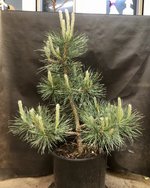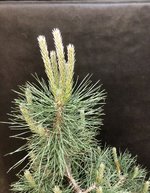It is surprising how many new shoots can be produced in the lower portion of the tree by using sacrifice branches and reducing apical leaders at the right time of year. One of the concepts that can be difficult to grasp in the beginning of working with pines. This tree pictured below was developed from a typical three or four year old pine similar in shape to yours. Note the amount of low branching present after development techniques have been applied for three years. A person now has as many options to choose from as desired in the bottom 12 to 18 inches of the tree! If you look closely, you can see the preponderance of shoots that formed even on the apical or upper most sacrifice leader. The original whorl is still in that bush, just reduced to ensure that knuckles or inverse taper does not form on the trunk. However, now one can select primary branches on the outside curves and with desired spacing. The new shoots are very easy to wire and position at this point. no struggling with older thicker branches all formed at the same level in the original whorls. The older branches have served their purpose to strengthen, thicken and support the health of the tree until new shoots in better positions are available. Wiring of the trunk early on in development has created the movement for design and branch positioning. ( hidden within the bush) The trunk has healed from this work and the tree is still young enough for significantly back budding to occur on the trunk. Now that you are working with new shoots you have many more years of back budding on the new branches to create density of foliage. This tree is seven years old at the time the picture was taken! Hope the above notes and picture help to explain the point I was trying to make in the other posts. " Most often it is better to develop options rather than select from the original juvenile form of a pine tree."
Special note: If one focuses solely on trunk girth for the first ten years then back budding like this is almost impossible on the lower portion of the tree. That is why a combination of growing and pruning techniques is worth considering rather than just in ground trunk growth as the first and only focus. Their are advantages to slowing trunk growth in order to develop nebari and lower branch options. plenty of time to thicken trunk after these areas have been developed. The sacrifice leader can be maintained or replaced as taper is built from the ground up! Each new apical leader can be left with one or more lateral shoots for new sacrifice leaders after removing the original. The good news is that there is plenty of time in each growing season to figure out the next step when developing pines. One of the best written sources available on this topic are the Pine Development series written by Jonas Dupuich and available in the archives portion of his Bonsai Tonight website. Jonas is an excellent writer and can explain things much better than I can.
 View attachment 378693
View attachment 378693Can either of both of you 2 experts expand on some of this . Frank you mentioned back bidding after reducing the apicisl leader . I get the grow box and let them grow . But have struggled to get the results in your pic . I live Canada Ontario zone 4 so don’t have the growing season frank does . Manly grow Scot’s and aust Pine for old hardiness . Frank noticed I another thread . You keep your boxed pines grouped together . Surprised me thinking they need more space for light . Do you guys pluck or cut old needles to promote sunlight for back budding . Any advice on fertilizer at this grow stage . Sorry to ask so many questions but you obviously know what your doing . Hope to improve my trees In development .Tbe timing and work needed to achieve the back budding seem my main interest thank you






